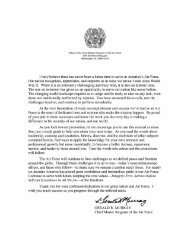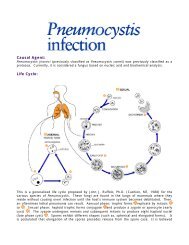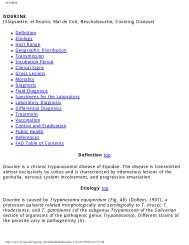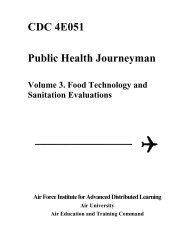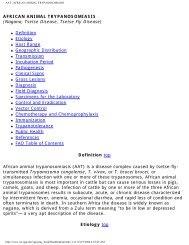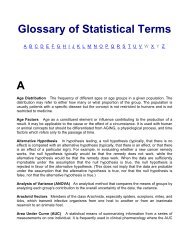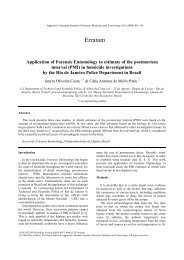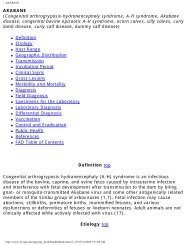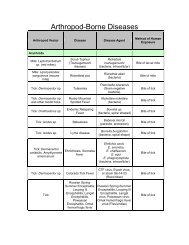HEMORRHAGIC SEPTICEMIA
HEMORRHAGIC SEPTICEMIA
HEMORRHAGIC SEPTICEMIA
Create successful ePaper yourself
Turn your PDF publications into a flip-book with our unique Google optimized e-Paper software.
<strong>HEMORRHAGIC</strong> <strong>SEPTICEMIA</strong><br />
recovered from hemorrhagic septicemia occurring in Egypt, the Sudan, the<br />
Republic of South Africa, and several other African countries. There is no report of<br />
either serotype being recovered from Australia, New Zealand, and countries of<br />
South and Central America.<br />
There is no evidence that the disease has spread from carrier bison in the Western<br />
United States to neighboring cattle. Given the conditions in which hemorrhagic<br />
septicemia occurs in endemic areas (e.g., primitive husbandry practices, low<br />
country plains, and well-defined dry and wet seasons), it seems unlikely that the<br />
disease will reach epidemic proportions in the United States.<br />
Transmission top<br />
The disease is spread by direct and indirect contact (fomites). The source of the<br />
infection is infected animals or carriers. The carrier state may be greater than 20<br />
percent shortly after an outbreak, but within 6 weeks the rate is usually less than<br />
5 percent. The causal agent does not survive for more than 2 to 3 weeks in the<br />
soil or on pastures. Close herding and wetness, as occurs during the rainy season,<br />
appear to contribute to spread. There is no evidence that biting arthropods are<br />
significant vectors.<br />
Incubation Period top<br />
The influence of extrinsic factors in the development of the clinical pasteurelloses,<br />
and particularly in hemorrhagic septicemia, has been noted by many workers.<br />
When favorable circumstances for the growth and multiplication of P. multocida in<br />
the animal body occur, severe septicemia develops within a few hours. However,<br />
the organisms may be harbored for varying periods in a small percentage of<br />
carrier animals without any clinical sign. The perpetuation of the disease from year<br />
to year or season to season is generally attributed to the carrier state. The<br />
immune status of the animal is thought to influence the severity of the disease.<br />
Cattle or buffalo artificially inoculated subcutaneously with lethal doses<br />
(approximately 20,000 bacilli) show clinical signs within a few hours and succumb<br />
within 18 to 30 hours.<br />
Clinical Signs top<br />
The majority of cases in cattle and buffalo are acute or peracute with death<br />
occurring from 6 to 24 hours after the first recognized signs. In a few outbreaks,<br />
animals may survive as long as 72 hours. Dullness, reluctance to move, and<br />
elevated temperature are the first signs. Following these signs, salivation and<br />
http://www.vet.uga.edu/vpp/gray_book/Handheld/hes.htm (3 of 8)3/5/2004 4:15:01 AM



